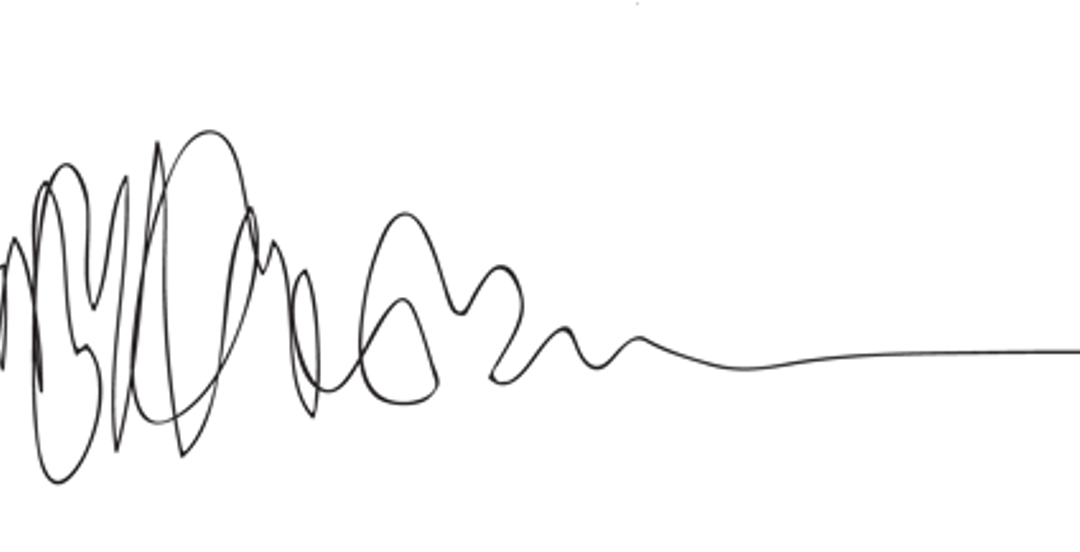“We are not lost. I know exactly where we are. Granted, it’s not where we want to be. Where we want to be is over there somewhere. I just need a moment to figure out how we get there.”
– Me to my husband every time we go to a new city and I convince him to go on a walk.
The Big Squiggly
Last week, the 13th class of Driving Intrapreneurship graduated and, as always, I was tremendously proud of the executives who, in the span of 8 short weeks, went from identifying a problem to writing an innovation business plan to secure funding and resources to continue their work.
One of the things we talk about constantly in the course is “The Big Squiggly” – a simple line drawing that starts off as a big, knotty, crumpled, chaotic mess before eventually sorting itself out and turning int a clean and simple straight line.
We spend most of the 8 weeks in The Big Squiggly and it’s even more uncomfortable and stressful than people imagine it will be when I first introduce the concept. But as the weeks go on, they get a little more comfortable and, by graduation, the mere mention of The Big Squiggly elicit knowing nods and confident smiles.
What To Do When You’re In The Big Squiggly
Innovators live in The Big Squiggly. Some of us love it there and some of us endure it because really, all we want to do, is bring order to chaos. Most of us in The Big Squiggly are like my students – uncomfortable at best and deeply stressed at worst.
In fact, being in The Big Squiggly can feel like being in the middle of a crisis.
Interestingly, they way innovators work through The Big Squiggly is very very similar to how leaders are taught to manage crises. Here is the 6-step approach that Harvard Professor Dutch Leonard teaches in his Crisis Management for Leaders course:
- Establish a team and process to identify, understand, and reframe issues
- Assemble a team with diverse perspectives
- Engage in iterative, agile problem-solving
- Create conditions (facilitated deliberation, diversity, psychological safety, inquiry not advocacy) for successful agile problem-solving
- Execute chosen actions but treat them as tentative and experimental
- Set reasonable expectations that you are making your best effort, learning rapidly, not everything will work, and we’ll keep working until it does
Hmmmmm, sounds exactly like how innovation works, too.
We’re all in The Big Squiggly Together
Everyone is innovating right now. From big companies responding to the Great Resignation and supply chain disruptions, to individuals trying to figure out whether and when to work form home or the office . We’re all doing something different, hoping it creates value, and pivoting until it does.
Yes, we are being forced to innovate and, like all innovation efforts, we’re not getting everything perfect but we’re learning a heck of a lot. Just imagine what we could do if we keep innovating when the crisis ends. Imagine the problems we could solve and the things we could create if we choose to continue to listen, learn, and experiment!
My friend, Dr. Anne Waple, has been a climate scientist for over 25 years. About a year ago, she spoke at Speakers Who Dare about her vision for Earth’s Next Chapter. Even in the early days of America’s response to COVID-19, Anne encouraged people to not just focus on problems because, when we do that, we don’t actually solve them. Instead, she asserted, driving positive, big, lasting global change starts when we ask questions about the world we want and believe we can have fun making it happen.
Together, We Can Get Out of The Big Squiggly
We are not lost. We’re just not where we want to be right now.
Yes, The Big Squiggly is uncomfortable and stressful. But it’s not forever. By asking questions about the world we want, we can define “over there somewhere.” How we get there is through innovation and we know and are already practicing the steps.
